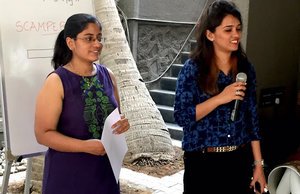Ideation
Life & work is full of challenges. How do we creatively tackle everyday challenges? One Monday Morning1, two young designers at Elephant2 share ideation as a tool to solve challenges.
“I haven’t failed. I have found 10,000 ways that won’t work”
Innovators are supposed to think new. What do accountants do when they are faced with challenges? Or, for that matter project managers or software coders? Is it possible to institutionalise creative thinking?
Tanmaya Rao & Shruti Jain, Designers at Elephant, conducted a workshop session that introduced ideation not just as a process but rather a tool to creatively look at problems. Given a set of constrains, individuals & teams were able to conjure solutions to unfamiliar challenges & constraints.
There were 3 main take-away from the Monday workshop;
#1
Working as co creative teams is an effective way to look at cracking a problem.
#2
Ideation cannot be a random process of simply starting to think at a given moment. It helps teams to arm themselves with a “Creative thinking technique” like SCAMPER6.
Such tools help look at challenges with a changing perspective. As with Thomas Edison, a technique can also help a team cover all angles and possible eliminate most ideas that don’t work.
#3
Participating teams went beyond using the tools to note down ideas, choose a few promising ones, go beyond to execute a couple of ideas and most important, share.
“Ideation without execution is delusion”, say’s, Robin Sharma. When an idea is executed, it gets tested and there is feedback. It is feedback and subsequent evolution or rejection of ideas that leads a team on to a path of problem solving.
It may help to institutionalize the act of ideation first as a mile stone is the process of looking at challenges (just like say, Root Cause Analysis8 is one such milestone when looking at challenges). Teams must realize that an idea alone is not good enough and a whole lot more thinking, detailing, execution, testing is required before a problem gets creatively solved. Theodore Levitt, American economist & Professor at HBS9 had famously remarked, “ Ideation is not a synonym for innovation, conformity is not its simple antonym and innovation is not an automatic consequence of creative thinking.”, indicating that creative ideation alone is not sufficient to solve problems.
Having said this, the workshop did provide non-design & design teams with a mind tool & technique to keep handy when facing a challenge.
Notes
- Monday Morning Meeting, is a weekly feature at 10:00 am where the entire Elephant team gets on to a share & learn platform.
- Elephant, is India’s independently leading Design Consulting organization www.elephantdesign.com .
- Thomas Alva Edison, 1847-1931, was an American inventor & businessman.
- Tanmaya Rao, is an Environment Designer working at Elephant.
- Shruti Jain, is an Environment Designer working at Elephant.
- SCAMPER, is an acronym for 7 ideation & thinking techniques, (S) substitute, (C) combine, (A) adapt, (M) modify, (P) put to another use, (E) eliminate and (R) reverse, credited to Bob Eberle.
- Robin Sharma, is a Canadian writer and leadership speaker, best known for his The Monk Who Sold His Ferrari series.
- Root Cause Analysis, (RCA) is a method of problem solving used for identifying the root causes of faults or problems.
- HBS, is Harvard Business School.





